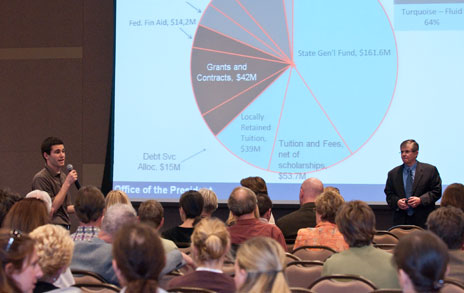
Photo by Reid Swan
The university’s budget difficulties may be mitigated by federal stimulus dollars and other revenue enhancements, but important budget questions remain unanswered.
Northern Arizona University President John Haeger solicited input Monday on how the university should use money from the American Recovery and Reinvestment Act to help offset NAU’s $21.3 million FY09 budget reduction and any cuts to the upcoming FY10 budget.
“However, all stimulus money is one time and will run out,” Haeger reminded the audience. “We need to decide what to do with the money with that in mind.” He added that the amount of stimulus money the university will receive is still unknown.
|
Speaking during a campus forum at the High Country Conference Center, Haeger listed some potential ways the money could be used, such as mitigating the effects of furloughs or to purchase software that would enhance productivity and create a near-paperless campus.
Haeger scheduled the forum to update campus on the university budget, including the cuts already made to contend with the budget reduction, which could grow worse in FY10.
In addition to the recent cuts made by all vice presidential areas, including Academic Affairs, the president outlined some revenue enhancements, which he said are necessary to continue to deliver a high-quality experience for students.
NAU has proposed to add a $175-a-semseter tuition surcharge for students who are not already in the Pledge tuition guarantee program. It also will ask the Arizona Board of Regents to approve an IT fee increase to $36 a semester.
An additional revenue source will be a new fee that will partially offset charges credit card companies levy against the university when students use charge cards for payments.
Haeger praised a budget plan from Gov. Jan Brewer that would mix cuts with temporary tax revenues and a budget modernization plan. He also praised an “excellent” report from the Fiscal Alternative Choices Team, which included Marc Chopin, dean of The W.A. Franke College of Business, and NAU economic professor Ronald Gunderson.
FACT is a team of experts from Arizona’s universities and the Arizona Board of Regents, created at the request of legislative leadership, who identified alternative strategies that could address both the short-term deficit and also long-term structural budget issues.
Amid continuing stress on state and university budgets, the president also discussed methods for educating more students at less cost per baccalaureate and in a shorter amount of time. He added that graduating more students with baccalaureate degrees cannot be done by sacrificing quality.
He explained that Northern Arizona University could embark on creating “regional universities” that would be developed in coordination with community colleges and the local communities.
“We would build a strong regional partnership, using existing faculty, staff and buildings,” Haeger said. “We also would seek broad regional support—communities would need to come up with funding.”
Some of the characteristics of a regional university include structured programs, fewer electives and a hybrid delivery system blending onsite with online.
Haeger cited NAU partnerships in Yuma and Yavapai County as examples of where a regional institution could develop.



